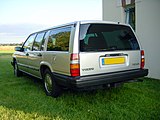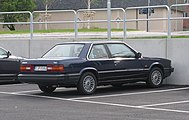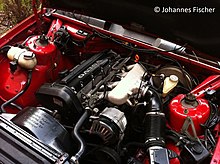Volvo 700 series
| Volvo | |
|---|---|
|
Volvo 740 GL (1984-1989)
|
|
| 700 series | |
| Production period: | 1982-1992 |
| Class : | upper middle class |
| Body versions : | Sedan , station wagon , coupé |
| Engines: |
Otto engines : 2.0–2.9 liters (83–147 kW) Diesel engines : 2.4 liters (60–95 kW) |
| Length: | 4785 mm |
| Width: | 1760 mm |
| Height: | 1435 mm |
| Wheelbase : | 2770 mm |
| Empty weight : | 1275-1500 kg |
| Previous model | Volvo 240 |
| successor | Volvo 900 series |
The Volvo 700 series was a model name from the Swedish car manufacturer Volvo for a car model that was produced as a sedan, as well as a station wagon and a coupé .
Type designation
The type designation differentiated sedans and station wagons of the 740 and 760 models as well as the 780 Coupé . The 760 was available with a six-cylinder petrol engine and was better equipped than the 740 (e.g. standard light alloy rims, higher-quality interior with velor seats, more chrome in the radiator grille). The 780 in turn was only available as a coupé version.
The structure of the type designation was structured as follows:
The first number indicated the series (here the 700 series). The second digit was the number of cylinders in the engine. The third digit referred to the number of doors.
For example, a Volvo Type 745 was a station wagon with a four-cylinder engine and a Volvo Type 764 was a sedan with a six-cylinder engine.
No rule without exceptions:
- The diesel engines were given the type designation 740, depending on the equipment, even though they had six cylinders.
- The most powerful versions of the four-cylinder petrol engines were also offered in the 760.
- All coupés had the type designation 780, but no variant had more than six cylinders.
history
With the 760, the first model of the 700 series was presented in early 1982. It was a new design. In spring 1984 the 740 was added to the range, initially as a sedan. The station wagon versions of both vehicles followed in spring 1985. As a third variant, the Coupé 780 was brought onto the market in the summer of 1985, but it was not imported to Germany.
After two years of parallel construction of the 700 and 900 series , the 700 series was finally discontinued in late summer 1992.
At the same time, Volvo sold the 200 series until mid-1993, which led to a difficult market positioning with two very similar car models.
The angular design gave the 700 models nicknames such as “Container-Volvo”, “Swedish Bricks” or just “Bricks”. Jan Wilsgaard was responsible for the design .
In addition to the Scandinavian countries, the GDR government also used the Volvo 700 series as a representation and government vehicle.
Market situation
Although Volvo also sold the comparable 200 series, the 700 series enjoyed great popularity, certainly also because the 700 series has a c w value and, from 1988 onwards, the rear axle technology for sedans as well, see section Technology, the more modern Vehicle was.
During the twelve-year production period, around 1.25 million 700s were built, around 830,000 sedans, 400,000 station wagons and around 8,500 coupés of the 780 .
In Europe, the station wagon was more popular than the sedan, as it was one of the largest on the market with a load volume of up to 2200 l. The sedan found more buyers on the US market.
The current market situation on the used market is favorable for buyers. Although the end of production is now more than twenty years ago, no increased demand can be determined for the 700 series on the used car market. Sedans in particular are hardly in demand on the market. Station wagons achieve comparable prices to competing products at the time, depending on their equipment, mileage and maintenance condition. Due to the extensive galvanization of the 700 models at that time, these models are largely immune to rust from the production year 1990. The hatchbacks of the combi models are made of aluminum and therefore often have harmless areas of corrosion.
technology
All 700 models are rear-wheel drive . The 700 series station wagons and 740 sedans had a rigid axle at the rear , as did the 760 sedan and the 780 coupé up to and including model year 1987. From model year 1988, a new split rear axle ( multi-link axle ) was used in the top models of the 700 series sedans.
Both gasoline and diesel engines were used in the 700 series.
Typical four-cylinder gasoline engines with catalytic converters , which have a gray cast iron crankcase and an aluminum cylinder head as well as a toothed belt , were in Germany:
- B200F - 1986 cm³ displacement with 82 kW / 111 PS
- B230F - 2316 cc displacement with 85 kW / 115 PS
- B230FB - 2316 cm³ displacement with 96 kW / 131 PS
- B234F - 2316 cm³, 16 valves with 114 kW / 155 PS
- B230FT - 2316 cm³ displacement, turbocharger with 114 kW / 155 PS or 121 kW / 165 PS
- B230ET - 2316 cm³ displacement, turbocharger with 133 kW / 182 PS
Typical six-cylinder diesel engines (from VW license) in Germany were:
- D24 - 2383 cm³ displacement with 60 kW / 82 PS (only 740)
- D24T - 2383 cm³ displacement, turbocharger with 80 kW / 109 PS (740 & 760)
- D24TIC - 2383 cm³ displacement with turbocharger and intercooler with 90 kW / 122 PS (740 & 760; 129 PS in the 780)
Typical six-cylinder gasoline engines without a catalytic converter in Germany were:
- B28E - 2849 cm³ displacement with 115 kW / 156 PS
Typical six-cylinder gasoline engines with catalytic converters in Germany were:
- B280F - 2829 cc displacement with 108 kW / 147 PS
In addition, various engine variants were produced for other markets.
All Volvo engines of that time are now considered long-life power units if properly cared for. Engine mileage of 300,000 km and more are not uncommon. In the case of the 16-valve, however, the timing belt replacement intervals must be meticulously observed.
For the engines B200F, B230F, B230FB and B230FT there are conversion kits with which they achieve the emission class Euro 2.
Either 4 + 1 overdrive gearboxes (designation M46) or five-speed gearboxes (M47) or automatic gearboxes of the type ZF4HP22 or AW70 or AW71 were used.
Individual evidence
- ↑ a b c d e auto-motor-und-sport.de of April 24, 2019, Volvo 740/760 strengths and weaknesses ... , accessed on August 21, 2019.
- ↑ auto-motor-und-sport.de/oldtimer of June 29, 2012, purchase advice for Volvo 740/760/940/960 The Great Swede , accessed on August 22, 2019.
- ↑ Engine codes Volvo 740 . Mobile directory. Archived from the original on March 11, 2011. Retrieved on December 7, 2010.
- ↑ auto-motor-und-sport.de/oldtimer/ from February 13, 2013, driving report Volvo 740 GLT 16 Valve , available on August 22, 2019.
Web links
- auto-motor-und-sport.de from April 24, 2019, Volvo 700-740-760 strengths and weaknesses ...
- private page Extensive data collection on the Volvo 700 , August 21, 2019 unfortunately not functional.
- auto-motor-und-sport.de/oldtimer/ Driving report Volvo 740 GLT 16 Valve , available on August 22, 2019.




